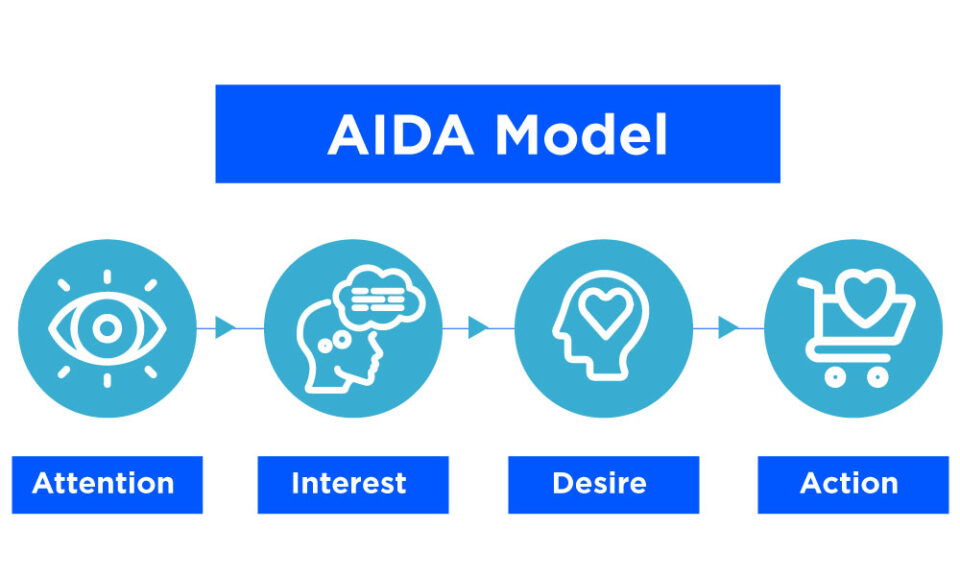Have we ever thought why some ads stay in our mind while others fade away? There is a reason behind it. The marketers imply the AIDA model to represent their ads effectively. It is a powerful marketing tool that helps guide potential customers through their buying journey.
Created by Elias St. Elmo Lewis in 1898, this four-step process remains relevant today. By understanding and applying this model, marketers can craft messages that not only capture attention but also drive consumers to take action, ultimately boosting conversions and sales.
This blog discusses the AIDA model, its four steps, advantages, and disadvantages in detail. Let’s get started!
AIDA Model – Interpretation
In "AIDA," the initial "A" stands for attention. The final "A" denotes action, while the letters "I" and "D" stand for interest and desire.
Based on the hierarchy of effects theory, this four-stage approach requires customers to progress through each step in order to do the desired action in the end.
Like a standard marketing funnel, each step contains fewer customers than the one before it; still, it is less flexible and more linear to accommodate various user experiences.
Elias St. Elmo Lewis, who was later inducted into the Advertising Hall of Fame, established this advertising formula in 1898.
AIDA Model Steps Explained

1. Attention
Many marketers tend to neglect the attention component. Customers are presumed to have already taken notice of the product or service, while this may or may not be the case. In any case, don't presume that your product is already well known. One of the most effective strategies for getting customers' attention is "creative disruption," which involves using a really original message to break previous behavioral patterns.
There are various ways for this:
- Putting ads in unexpected places or circumstances.
- Using provocative imagery to create shock in ads.
- A message that is highly targeted.
The goal is to inform consumers that an item or service is available.
2. Interest
The hardest thing is usually creating curiosity. This can be extremely challenging to accomplish, for instance, if the product or service is not intrinsically engaging. Make sure the advertising content is readable and well-organized, with captivating subheadings and graphics. Concentrate on the aspects of your product or service that are most vital to your target market and only deliver the most crucial message you wish to get across to them.
3. Desire
Helping people understand why they "need" a good or service is important. Consider the way ads offer their content. They try to provide viewers with engaging details about the product and the advantages of purchasing it, which should increase their desire for it.
Advertisements excel at this by showcasing the goods in a variety of inventive settings. Explain to the audience the benefits of the good or service and the reasons they require it.
4. Action
Getting your customer to take action is the final step in the AIDA methodology. A call to action or a remark intended to generate an instant response from the customer should conclude the ad.
Customers should be inspired to act immediately by effective advertising that creates a sense of urgency. Making temporary offers is a popular strategy for accomplishing this aim.
Advantages of the AIDA Model
- The AIDA model provides a clear structure for creating marketing messages, making it easy to follow.
- It enhances effective communication by addressing each stage of the buyer's journey, which can increase conversion chances.
- This model is versatile and can be applied across various marketing channels, making it flexible for different campaigns.
- AIDA helps marketers understand and predict consumer behavior, allowing for tailored strategies that meet customer needs.
Disadvantages of the AIDA Model
- The model may oversimplify complex consumer decision-making processes, ignoring important emotions and social influences.
- It assumes a linear flow from one stage to the next, which may not accurately reflect how real customers make decisions.
- AIDA doesn’t emphasize incorporating ongoing customer feedback, which is crucial for refining marketing strategies.
- It may not be universally applicable, as some products or services in niche markets might not fit neatly into the framework.
Wrapping Up!
The AIDA model offers a clear and effective way to engage customers and enhance marketing strategies. While it has its limitations, its structured approach can significantly improve communication and conversion rates.
By mastering each step - capturing attention, sparking interest, generating desire, and prompting action - marketers can create compelling campaigns that resonate with their audience and drive results in today's competitive era.
Through our blog content, we made an effort to help our readers, and we hope this is worth it. To get more knowledge giving and insights providing content, keep visiting us at WisdomPlexus.
You may also like to read:
Customer Centric Marketing Strategies
Overview and Aspects of Business Intelligence in Marketing




